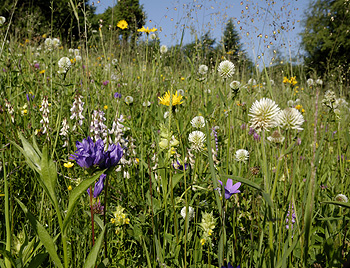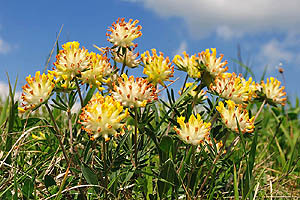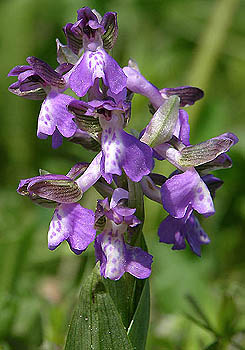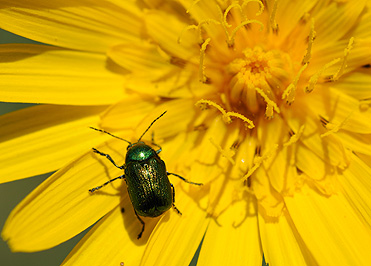Meadows
 The Pieniny meadows constitute a very important element of the landscape, despite the fact that are they are not truly natural communities - the area they occupy was once forest. Although they cover a much smaller area than the forests, they have become highly diversified. The floral composition of the Pieniny meadows differs from those in the Beskidy or Tatra mountains, and is a consequence of the interaction of specific climatic and soil conditions (and the underlying geology) as well as the patterns of mixed farming. Meadows located within the Park boundaries are colourful and rich in species and are especially attractive. In a single square metre one can find about 30-40 species of flowering plants, and in certain 100 square metre patches it is possible to spot as many as 70. The great diversity of mosses and cup mushrooms are encouraged by hay cultivation and are highly pried.
The Pieniny meadows constitute a very important element of the landscape, despite the fact that are they are not truly natural communities - the area they occupy was once forest. Although they cover a much smaller area than the forests, they have become highly diversified. The floral composition of the Pieniny meadows differs from those in the Beskidy or Tatra mountains, and is a consequence of the interaction of specific climatic and soil conditions (and the underlying geology) as well as the patterns of mixed farming. Meadows located within the Park boundaries are colourful and rich in species and are especially attractive. In a single square metre one can find about 30-40 species of flowering plants, and in certain 100 square metre patches it is possible to spot as many as 70. The great diversity of mosses and cup mushrooms are encouraged by hay cultivation and are highly pried.
 Thermophilous meadow Anthyllidi-Trifolietum, where Kidney Vetch Anthyllis vulneraria, Clover Trifolium montanum and T. medium are found, is highly valued and renowned for being one of the richest community types in Poland. It occupies only 6% of the total area covered by meadows and can thrive in areas that were formerly primeval beech forest habitats (Dentario glandulosae – Fagetum typicum). Mowing in late July, removing the biomass and limited fertilization are prerequisite conditions for the maintenance of this community type; when mowing ceases, the forest species can encroach allowing natural afforestation to occur; excessive fertilization can result in deleterious changes in species composition.
Thermophilous meadow Anthyllidi-Trifolietum, where Kidney Vetch Anthyllis vulneraria, Clover Trifolium montanum and T. medium are found, is highly valued and renowned for being one of the richest community types in Poland. It occupies only 6% of the total area covered by meadows and can thrive in areas that were formerly primeval beech forest habitats (Dentario glandulosae – Fagetum typicum). Mowing in late July, removing the biomass and limited fertilization are prerequisite conditions for the maintenance of this community type; when mowing ceases, the forest species can encroach allowing natural afforestation to occur; excessive fertilization can result in deleterious changes in species composition.  Thermophilous meadow is almost uniquely found in the Pieniny region, but some poor imitations of this community can be found in adjacent mountain ranges. This meadow type is resplendent with numerous species of orchids including Dactylorhiza sambucina, Green-winged Orchid Orchis morio, Early purple Orchid Orchis mascula, Common spotted Orchid Dactylorhiza fuchsii, Narrow-leaved marsh Orchid Traunsteinera globosa, Lesser butterfly Orchid Platanthera bifolia, Fragrant Orchid Gymnadenia conopsea, Frog Orchid Coeloglossum viride. Other interesting plants are: Gladiolus Gladiolus imbricatus, Greater Knapweed Centaurea scabiosa, Rest-harrow Ononis arvensis.
Thermophilous meadow is almost uniquely found in the Pieniny region, but some poor imitations of this community can be found in adjacent mountain ranges. This meadow type is resplendent with numerous species of orchids including Dactylorhiza sambucina, Green-winged Orchid Orchis morio, Early purple Orchid Orchis mascula, Common spotted Orchid Dactylorhiza fuchsii, Narrow-leaved marsh Orchid Traunsteinera globosa, Lesser butterfly Orchid Platanthera bifolia, Fragrant Orchid Gymnadenia conopsea, Frog Orchid Coeloglossum viride. Other interesting plants are: Gladiolus Gladiolus imbricatus, Greater Knapweed Centaurea scabiosa, Rest-harrow Ononis arvensis.
Amongst the Pieniny meadows, the largest area is covered by the association of Campanula patula – Trisetum flavescens with Spreading Bellflower Campanula patula and Yellow Oat Trisetum flavescens as distinctive species. In terms of species composition these are similar to the Arrhenatheretum elatioris meadow.
flavescens as distinctive species. In terms of species composition these are similar to the Arrhenatheretum elatioris meadow.
On higher ground the floral composition of the meadows changes. Glades located on higher ground in the Three Crowns massif are occupied by tall herb meadows. These are characterized by more luxuriant plant cover than that found in thermophilous meadows, despite being mowed irregularly (every 2-3 years). The dominant species here are herbs: Veratrum lobelianum, Leserpitium latifolium, Tanacetum corymbasum subsp. clusii. In the early spring the meadows become a sea of snowdrops Galanthus nivalis.
Marshy fens are found around springs. The water in Pieniny is rich in calcium carbonate and mineral salts which is why it supports only the eutrophic mountain fen association (Valeriano-Caricetum flavae). Characteristic species for this association are Valeriana simplicifolia, Carex davalliana, Common Yellow Sedge Carex flava and Broad-leaved Cotton Grass Eriophorum latifolium. This is also a suitable habitat for the insectivorous Common Butterwort Pinguicula vulgaris and the beautiful Marsh Helleborine Epipactis palustris orchid.
 The Pieniny meadows, due to their species diversity and richness, provide thousands of stenothermal and photophilous insects with a plentiful supply of food. On hot summer days the air seems to hum with the buzzing of flying dipterans Diptera, hymenopterans Hymenoptera and grasshoppers Orthoptera. It is also possible to enjoy sightings of numerous and various butterflies.
The Pieniny meadows, due to their species diversity and richness, provide thousands of stenothermal and photophilous insects with a plentiful supply of food. On hot summer days the air seems to hum with the buzzing of flying dipterans Diptera, hymenopterans Hymenoptera and grasshoppers Orthoptera. It is also possible to enjoy sightings of numerous and various butterflies.








